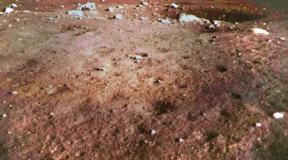Scientists have named the real color of the moon. Leonid Konovalov Real color of the moon
The question in the title seems very strange. After all, everyone has seen the Moon and knows its color. However, on the Internet, you periodically come across the idea of a worldwide conspiracy hiding the true color of our natural satellite.
Discussions about the color of the Moon are part of the vast topic of the “lunar conspiracy.” Some people think that the cement color of the surface, which is present in the photographs of the Apollo astronauts, does not correspond to reality, and “in reality” the color there is different.
A new aggravation of the conspiracy theory was caused by the first images of the Chinese lander Chang'e 3 and the Yutu lunar rover. In the earliest images from the surface, the Moon appeared more like Mars than the silver-gray plain seen in the 60s and 70s.

Not only numerous home-grown whistleblowers, but also incompetent journalists from some popular media outlets rushed to discuss this topic.
Let's try to figure out what the secrets are with this Moon.
The main postulate of the conspiracy theory related to the color of the moon is: “NASA made a mistake in determining the color, so during the Apollo landing simulation it made the surface gray. In fact, the Moon is brown, and now NASA is hiding all color images of it.”
I came across a similar point of view even before the landing of the Chinese lunar rover, and it is quite simple to refute it:

This is a high-color image from the Galilleo spacecraft taken in 1992, at the beginning of its long journey to Jupiter. This frame alone is enough to understand the obvious thing - the Moon is different, and NASA does not hide it.
Our natural satellite experienced a turbulent geological history: volcanic eruptions raged on it, giant lava seas spilled, and powerful explosions occurred caused by impacts of asteroids and comets. All this significantly diversified the surface.
Modern geological maps, obtained thanks to numerous satellites of the USA, Japan, India, China, demonstrate a variegated diversity of the surface:

Of course, different geological rocks have different compositions and, as a result, different colors. The problem for an outside observer is that the entire surface is covered with homogeneous regolith, which “blurs out” the color and sets one tone over almost the entire area of the Moon.
However, today there are several astronomical survey and image post-processing techniques available that can reveal hidden surface differences:

Here is an image by astrophotographer Michael Theusner, which was taken in multi-channel RGB mode, and processed by the LRGB algorithm. The essence of this technique is that the Moon (or any other astronomical object) is first photographed alternately in three color channels (red, blue and green), and then each channel is subjected to separate processing to express color brightness. An astro camera with a set of filters, a simple telescope and Photoshop are available to almost everyone, so no conspiracy can help hide the color of the Moon. But this will not be the color that our eyes see.
Let's go back to the moon and the 70s.
Published color images from a 70mm Hasselblad camera mostly show us the uniform “cement” color of the Moon.
At the same time, the samples delivered to Earth have a richer palette. Moreover, this is typical not only for Soviet supplies from Luna-16:

But also for the American collection:

However, they have a richer selection, there are brown, gray, and bluish exhibits.
The difference between observations on Earth and on the Moon is that the transportation and storage of these finds cleared them of the surface dust layer. Samples from Luna-16 were generally obtained from a depth of about 30 cm. At the same time, during filming in laboratories, we observe finds in different lighting and in the presence of air, which affects the scattering of light.
My phrase about moon dust may seem dubious to some. Everyone knows that there is a vacuum on the Moon, so there cannot be dust storms like there are on Mars. But there are other physical effects that raise dust above the surface. There is an atmosphere there, but it’s very thin, about the same as at the height of the International Space Station.
The glow of dust in the lunar sky was observed from the surface by both the automated Surveyor landers and Apollo astronauts:

The results of these observations formed the basis of the scientific program of the new NASA spacecraft LADEE, whose name means: Lunar Atmosphere and Dust Environment Explorer. Its task is to study lunar dust at an altitude of 200 km and 50 km above the surface.
Thus, the Moon is gray for much the same reason that Mars is red - due to the covering of monochromatic dust. Only on Mars, red dust is raised by storms, and on the Moon, gray dust is raised by meteorite impacts and static electricity.
Another reason that prevents us from seeing the color of the Moon in the photographs of astronauts, it seems to me, is a slight overexposure. If we lower the brightness and look at the place where the surface layer is broken, we can see the difference in color. For example, if we look at the trampled area around the Apollo 11 lander, we will see brown soil:

Subsequent missions carried with them the so-called. “gnomon” is a color indicator that allows you to better interpret the color of a surface:

If we look at it in the museum, we can see that the colors look brighter on Earth:

Now let's look at another image, this time from Apollo 17, which once again confirms the absurdity of accusations of deliberate “bleaching” of the Moon:

You may notice that the excavated soil has a reddish tint. Now, if we lower the light intensity, we can see more of the color differences in the lunar geology:

By the way, it is no coincidence that these photographs in the NASA archive are called “orange soil”. In the original photograph, the color does not reach orange, and after darkening, the color of the gnomon markers approaches those visible on Earth, and the surface acquires more shades. This is probably how the eyes of the astronauts saw them.
The myth about deliberate discoloration arose when some illiterate conspiracy theorist compared the color of the surface and its reflection on the glass of an astronaut’s helmet:

But he was not smart enough to realize that the glass was tinted and the reflective coating on the helmet was gold. Therefore, the change in color of the reflected image is natural. The astronauts worked in these helmets during training, and there the brown tint is clearly visible, only the face is not covered with a gold-plated mirror filter:

When studying archival images from Apollo or modern ones from Chang’e-3, it should be taken into account that the color of the surface is also affected by the angle of incidence of the sun’s rays and camera settings. Here is a simple example when several frames of the same film on the same camera have different shades:

Armstrong himself spoke about the variability of the color of the lunar surface depending on the angle of illumination:
In his interview, he does not hide the observed brown tint of the Moon.
Now about what the Chinese devices showed us before going into a two-week night hibernation. The first frames they took in pink tones were due to the fact that the white balance on the cameras was simply not adjusted. This is an option that all digital camera owners should be aware of. Shooting modes: “daylight”, “cloudy”, “fluorescent lamp”, “incandescent lamp”, “flash” - these are precisely the white balance adjustment modes. It is enough to set the wrong mode and either orange or blue tints begin to appear in the pictures. No one set the Chinese cameras to “Moon” mode, so they took the first shots at random. Later we tuned in and continued shooting in those colors that are not very different from the Apollo frames:




Thus, the “lunar color plot” is nothing more than a delusion based on ignorance of banal things and the desire to feel like a ripper without leaving the couch.
I think the current Chinese expedition will help us get to know our space neighbor even better, and will once again confirm the absurdity of the idea of a NASA lunar conspiracy. Unfortunately, media coverage of the expedition leaves much to be desired. For now, we only have access to screenshots from Chinese news broadcasts. It appears that CNSA no longer wants to disseminate information about its activities by any means. I hope this will change at least in the future.
In the photographs transmitted by the Jade Hare, the surface of our natural satellite for some reason appears brown, not gray.
11:33 The first mysterious discovery of the Chinese lunar rover: the Moon is not the same color as the Americans. In the photographs transmitted by the Jade Hare, the surface of our natural satellite for some reason appears brown, not gray. The Chinese lunar rover, the Jade Hare, slides down onto the brown surface of the Moon. Photo: Xinhua
“I don’t know why NASA bleached the images,” says the famous American researcher of anomalous phenomena Joseph Skipper. - They're probably hiding something. After all, as a rule, by removing the natural color of an object, its structure is masked. And the structure, in turn, can reveal certain details that should not come to the attention of the uninitiated. According to the researcher, part of the photo with the flag was simply not processed due to an oversight. And the trick was revealed. But the Chinese didn’t process anything at all. They didn't know it was supposed to be like that. The Americans did not warn them.
Members of the Apollo 10 crew also testified that the Moon is brown. Then, in May 1969, the pilot of the lunar module was the same Eugene Cernan, the commander was Thomas Stafford, and the pilot of the command module was John Young. The astronauts were choosing a landing site for Neil Armstrong and Buzz Aldrin, who were to be the first to set foot on the Moon... Cernan and Stafford undocked from the command module and approached the surface at 100 meters. We examined its color in detail. A detailed report was compiled about this. And they took pictures. In the report of the Apollo 10 crew, pardon the pun, it is written in black and white that the Moon is sometimes light brown, sometimes reddish-brown, sometimes the color of dark chocolate. But not gray at all.
Pictured is Eugene Cernan, commander of the Apollo 17 crew that landed on the Moon in December 1972. Landed with lunar module pilot Harrison Schmit.
Cernan plants an American flag and takes a photo of himself, holding the camera at arm's length. Shmit walks around the lunar module, which is in front of Cernan.
Both the flag and the astronaut’s spacesuit turned out to be bright and colorful. And the lunar surface is black and white. As usual.
But attention!
Take a look at the glass of the helmet. It reflects both the lunar module and the surface on which it stands.
Photo from Apollo 10: blue Earth rising above a brown Moon.
The surface is brown. And this is the real color of the Moon.
I don't know why NASA bleaches the pictures, says Joseph Skipper. - They're probably hiding something. After all, as a rule, by removing the natural color of an object, its structure is masked. And the structure, in turn, can reveal certain details that should not come to the attention of the uninitiated.
According to the researcher, part of the photo with the flag was simply not processed due to an oversight. And the trick was revealed.
THE TRUTHFUL GUYS FROM APOLLO 10
It would be reckless to judge the “correct” color of the entire Moon by the reflection in the glass of a helmet. You never know what brown is reflected there. However, there are other “evidences”. The most important are the testimonies of the Apollo 10 crew members. Then, in May 1969, the lunar module pilot was the same Eugene Cernan, the commander was Thomas Stafford, and the command module pilot was John Young. The astronauts were choosing a landing site for Neil Armstrong and Buzz Aldrin, who would be the first to set foot on the moon just a couple of months later.
Cernan and Stafford undocked from the command module and approached the surface to within 100 meters. We examined its color in detail. A detailed report was compiled about this. And they took pictures.
In the report of the Apollo 10 crew, pardon the pun, it is written in black and white that the Moon is sometimes light brown, sometimes reddish-brown, sometimes the color of dark chocolate. But not gray at all.
In this photo the Moon is generally green...
And in some photographs taken from Apollo 10, it is generally green with bright red splashes.
Strangely, the photographs of Cernan, Stafford and Young were the last in which the Moon had color. Then, starting with the first American landing, it became black and white.
By the way, the astronauts from Apollo 17 found something amazing in color right next to the landing site. There is even a detailed video about this (see on the website kp.ru). Alas, the Americans do not show the find itself. But enthusiastic and many times repeated shouts can be clearly heard: “I can’t believe it... It’s incredible... It’s orange... It’s like something is rusty here.” We are talking about soil that astronauts are trying to collect in a bag. She was probably brought to Earth. But no one has yet reported what the find was.
Here you can see
23.10.2015 - admin
The first mysterious discovery of the Chinese lunar rover: the Moon is not the same color as the Americans.
In the photographs transmitted by the Jade Hare, the surface of our natural satellite for some reason appears brown, not gray.
Someone is deceiving someone
The Chinese rover Yutu, the Jade Hare, became the first vehicle to make a soft landing on the Moon after the last Americans, the crew of Apollo 17, Eugene Cernan and Harrison Schmit, left it in December 1972.
In December 2013, the “hare” successfully landed on the moon and transmitted images from its arrival site. And they revived the debate that had died down about what color the Moon is? In Chinese photos it is brown. In the sky - silver. The Moon is approximately the same color in numerous photographs taken by American astronauts directly on the surface of our natural satellite. This surface is either white or grayish-silver in the sun. And in the shadows it’s dark.
The Chinese lunar rover, the Jade Hare, slides onto the brown surface of the Moon
Photo: Xinhua

The Chinese photographed the surface of the Moon without the “hare” - it is brown.
Photo: Xinhua

American lunar rover of the Apollo 17 expedition - rides on the gray Moon
The famous American researcher of anomalous phenomena, Joseph Skipper, was the first to say that there was something wrong with the color of the Moon several years ago. He accused NASA of a dirty trick. They say that for some mysterious reason the agency processed lunar images posted on official websites in the public domain. The real color of the objects was removed from all of them, making the landscapes black and white. Like in an old movie.
Skipper's suspicions were strengthened by the photograph he found, one of those taken by the crew of the last Apollo. The photo shows Eugene Cernan planting an American flag and taking a photo of himself, holding the camera at arm's length. Shmit walks around the lunar module, which is located in front of both the flag and the astronaut’s spacesuit, which are bright and colorful. And the lunar surface is black and white. As usual. 
The moon is gray, but the helmet reflects brown.
Photo: NASA
But look at the glass of the helmet. It reflects both the lunar module and the surface on which it stands. The surface is brown. Just like in Chinese photographs from 2013. And it looks like this is the real color of the Moon.
“I don’t know why NASA whitened the images,” says Joseph Skipper. - They're probably hiding something. After all, as a rule, by removing the natural color of an object, its structure is masked. And the structure, in turn, can reveal certain details that should not come to the attention of the uninitiated.
According to the researcher, part of the photo with the flag was simply not processed due to an oversight. And the trick was revealed.
But the Chinese didn’t process anything at all. They didn't know it was supposed to be like that. The Americans did not warn them.
All shades of chocolate, not gray
Members of the Apollo 10 crew also testified that the Moon is brown. Then, in May 1969, the pilot of the lunar module was the same Eugene Cernan, the commander was Thomas Stafford, and the pilot of the command module was John Young. The astronauts were choosing a landing site for Neil Armstrong and Buzz Aldrin, who would be the first to set foot on the moon just a couple of months later.
Cernan and Stafford undocked from the command module and approached the surface to within 100 meters. We examined its color in detail. A detailed report was compiled about this. And they took pictures.
In the report of the Apollo 10 crew, pardon the pun, it is written in black and white that the Moon is sometimes light brown, sometimes reddish-brown, sometimes the color of dark chocolate. But not gray at all. 
Surface of the Moon taken from Apollo 10
Photo: NASA
And in some photographs taken from Apollo 10, it is generally green with bright red splashes.
Strangely, the photographs of Cernan, Stafford and Young were the last in which the Moon had color. Then, starting with the first American landing, it became black and white. 
In this photo the moon is green
Photo: NASA
By the way, the astronauts from Apollo 17 also found something amazing in color right next to the landing site. On Earth there were enthusiastic and many times repeated cries: “I can’t believe it... It’s incredible... It’s orange... It’s like something is rusty here.” We are talking about soil that astronauts are trying to collect in a bag. She was probably brought to Earth. But no one has yet reported what the find was.
INSTEAD OF A COMMENT
There's some secret here
USSR pilot-cosmonaut Alexei Leonov, who was friends with Stafford, explained to me about the color of the Moon at one time: it’s all about the film on which it was shot and the reflectivity of the surface.
“Each person perceives light in his own way,” said Alexey Arkhipovich. - Some people think it's a brown shade, others - a different shade. And photography is artificially invented layers. Any film is three colors. And a combination of three colors. The result depends on the processing. Depends on the angle of the light flux. One position of the light flux - one color. The sun is rising - a different color. A surface of the same color can reflect different wavelengths depending on the angle. And this is a different color.
I believe in Alexey Arkhipovich. But I still don’t understand: at first the Moon reflected so that it was brown, and then it began to reflect so that it became black and white on color film. And now she is brown again - in Chinese photographs.
There is some secret here. Or is there some kind of catch?
BY THE WAY
Where no American has gone before
According to the plan, the Jade Hare was supposed to land on the moon on December 16, 2013 in the Rainbow Bay (Sinus Iridum) of the Mare Imbrium. But for some reason he landed on December 14 and about 400 kilometers to the east - in the Sea of Rains itself. 
Landing sites of American and Soviet stations, Apollo landing sites
Photo: NASA
There are no earthly devices near the “Hare”. It’s as if the Chinese deliberately chose an untrodden area. The closest is the Soviet station “Luna-17”. It's about a thousand kilometers away. Somewhere near it is the Soviet Lunokhod-1, which the Chinese one is very similar in wheels to. 
Jade Hare landing site: in the Sea of Rains, not in Rainbow Bay.
Photo: NASA
The Apollo 15 landing site is more than 2,500 kilometers away. Apollo 17 is even further away. Or you could sit next to it to be sure to see the equipment left behind by the astronauts and photograph it. Or, conversely, not see it. To the delight of those who doubt that the Americans landed on the moon. However, the Chinese have their own plans.
In The first mysterious discovery of the Chinese lunar rover: the Moon is not the same color as the Americans
In the photographs transmitted by the Jade Hare, the surface of our natural satellite for some reason appears brown, not gray.
The Chinese lunar rover, the Jade Hare, slides down onto the brown surface of the Moon. Photo: Xinhua

The Chinese photographed the surface of the Moon without a hare - it is brown

The American lunar rover of the Apollo 17 expedition travels on the gray Moon. Photo: NASA

The moon is gray, but the helmet reflects brown. Photo: NASA
look at the glass of the helmet. It reflects both the lunar module and the surface on which it stands. The surface is brown. Just like in Chinese photographs from 2013. And it looks like this is the real color of the Moon.
— I don't know why NASA bleached the photo. and, says the famous American researcher of anomalous phenomena Joseph Skipper. — They're probably hiding something. After all, as a rule, by removing the natural color of an object, its structure is masked. And the structure, in turn, can reveal certain details that should not come to the attention of the uninitiated. According to the researcher, part of the photo with the flag was simply not processed due to an oversight. And the trick was revealed. But the Chinese didn’t process anything at all. They didn't know it was supposed to be like that. The Americans did not warn them.
Members of the Apollo 10 crew also testified that the Moon is brown. Then, in May 1969, the pilot of the lunar module was the same Eugene Cernan, the commander was Thomas Stafford, and the pilot of the command module was John Young. The astronauts were choosing a landing site for Neil Armstrong and Buzz Aldrin, who would be the first to set foot on the moon just a couple of months later. Cernan and Stafford undocked from the command module and approached the surface to within 100 meters. We examined its color in detail. A detailed report was compiled about this. And they took pictures. In the report of the Apollo 10 crew, pardon the pun, it is written in black and white that the Moon is sometimes light brown, sometimes reddish-brown, sometimes the color of dark chocolate. But not gray at all.

****************
How not to remember the movie "Moonrise":
If the Chinese were filming in the pavilion, but are they lying? I can't believe they joined a worldwide conspiracy. They have communism, censorship, execution for corruption and drug trafficking. If the deception is revealed, heads will roll. So, it turns out that the Chinese have uncovered lies and falsifications in NASA images of the Moon, just as they do with images of Mars.
The red color of the soil also indicates that it is iron oxides. And if these are oxides, then the Moon once had an atmosphere containing oxygen. In addition, it is much easier to find artifacts in color photographs. Is this what NASA is hiding from us?
In one of last year's issues of the magazine, in the "Correspondence with Readers" section, the note "Brown Moon" was published. But why does the Moon change color so often?
E. Kapustin (Simferopol).
Since ancient times, the moon has been associated with silver. However, the Moon has a very pure white color only during the day. This is because the blue light scattered by the sky adds to the yellowish light of the Moon itself. As the blue color of the sky weakens after sunset, it becomes more and more yellow and at some point pure yellow, and then, at the end of twilight, yellow-white again. For the rest of the night, the Moon retains a light yellowish color, exactly like the daytime Sun. On very clear winter nights, when the full Moon is high, its color appears whiter, but near the horizon it becomes as orange and red as the setting Sun.
If the Moon is surrounded by small purple-red clouds, its color becomes almost green-yellow, and if the clouds are orange-pink, then the Moon turns blue-green. Moreover, these contrasting colors appear more clearly for the crescent moon than for the full Moon.
With candles, for example, giving a reddish tint, the color of the Moon also appears greenish-blue. This contrast is especially clear if the light sources are not too strong, for example, if you simultaneously observe the reflection of the Moon and a gas flame in water. If you first look at the orange flame of a fire for about half an hour, and then at the Moon, the Moon will acquire a bluish tint.
And indeed: sometimes you can hear the expression “blue moon”. However, this is often called the second full moon of the month. Actually, the full moon does not always happen twice in the same month. Let us remember that the frequency of changes in lunar phases is approximately 29.5 days. Therefore, the second full moon in a month can only occur if the first was on the 1st of that month. For example, February can never be a "blue moon month."
Where did this unusual name come from? Hard to say. It is possible that it appeared during one of the months of two full moons shortly after 1883. That year there was a terrible eruption of the Krakatoa volcano - one of the most catastrophic in the entire chronicled history of mankind. A huge amount of volcanic ash and dust was released into the Earth's atmosphere. And for three years, the amount of solar energy reaching the surface of our planet was about 10% less than usual. Just at this time, the bluish-green color of the Sun and Moon was noted.
Or maybe some observer once noted a rare phenomenon of the so-called green ray near the setting full moon on the second full moon of the month? (See "Science and Life" No. 7, 12, 1980; No. 11, 1989; No. 8, 1993)
When the Moon and Sun are low on the horizon, they appear yellow, orange, and even blood red. This is due to the phenomenon of refraction of light rays in the Earth’s atmosphere and the state of the atmosphere itself.
Read also...
- Sooner or later, the secret always becomes clear
- The influence of lunar rhythms on health, energy, emotions, success in business and love
- How to pray correctly at home, in church, in front of an icon, relics, so that God hears and helps us: Orthodox church rules
- Leonid Konovalov Real color of the moon



















